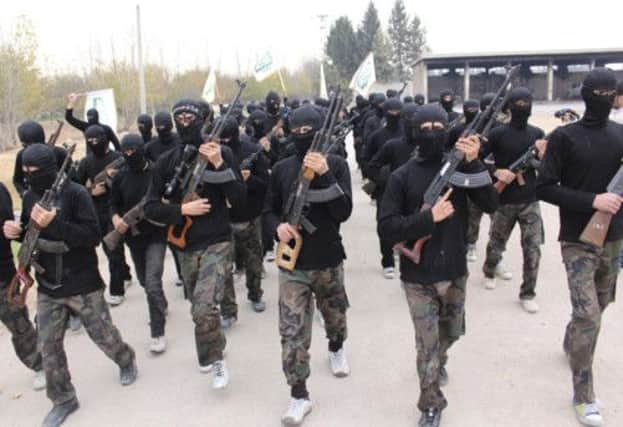Isis fighters instil fear to carve out heartland in Syria


They beheaded a sniper from a rival rebel unit, displayed his head in the town square and set up roadblocks. Not a shot was fired in the takeover, in which informants, including a local mullah, played key roles.
The scene in Termanin, recounted by an activist who witnessed it late last week, is being repeated in towns along the border with Turkey and at road junctions further inside Syria that have fallen out of president Bashar al-Assad’s control.
Advertisement
Hide AdAdvertisement
Hide AdWhether through weakness or a desire to focus on Assad’s forces, rebel units are making way for the Islamic State in Iraq and al-Shams (Isis), an al-Qaeda spin-off led by foreigners hardened by guerrilla wars in Iraq, Chechnya and Libya.
The land grab has given radical jihadists a base in the heart of a Middle East convulsed by the civil war raging in Syria since 2011. While constant conflict and shifting alliances mean Syria is a long way from becoming a centre for global jihad, western and Arab states backing moderate opponents of Assad are alarmed. Isis – the al-Shams in the name refers to Greater Syria – is taking over supply lines to rebel areas and attracting members of less organised opposition units by its efficiency, undermining efforts by the United States to contain it ahead of talks in Geneva on a possible peace deal, opposition sources and Middle East security officials say.
As well as an end to Assad’s rule, a key aim of such a deal would be to establish a government and moderate army capable of fighting off Isis, a Middle East diplomat said.
“Realistically it will be very difficult. We could be looking at a proxy sectarian war – whether Assad stays or goes – in which Isis will be a major player.”
Asked about the group’s goals, an Isis commander and Libyan veteran in Armanaz, northern Syria, said it is fighting for “the downfall of the tyrant Bashar” but was also seeking to impose Islamic law.
Learning lessons from the 2011 war in Libya, he said Isis was more determined to make real gains. “Our mistake as mujahideen is that we were preoccupied with fighting [Colonel Muammar al-] Gaddafi and did not pay enough attention to how to hold onto territory,” said the commander, nicknamed al-Jazaeri, or the Algerian.
In a sign of concern over Isis’s gains, the United Arab Emirates, a US ally, convened a meeting last week for dozens of tribal leaders from the oil-producing region of east Syria, bordering Iraq’s Sunni heartland.
Isis and the Nusra Front, a smaller al-Qaeda affiliate seen as less jihadist, occupy most oil fields in the eastern province of Deir al-Zor, although they lack the ability to operate the wells.
Advertisement
Hide AdAdvertisement
Hide AdThe UAE meeting sought to gauge the possibility of setting up a force akin to the Sahwa movement that fought al-Qaeda in Iraq, sources said, although neither the tribes nor Islamists seem ready for a sustained fight.
“There have been some clashes over oil but Isis has sought not to mess with the tribes. At the same time the tribes are seeing how Isis likes to chop heads and they too are not keen on a confrontation,” one source said.
Areas under Isis control include towns across the northern provinces of Idlib and Aleppo, parts of the eastern provincial capital of Raqqa and, to a lesser extent, of central Syria and the southern province of Deraa.
In some of these it is trying to implement a rigid Islamist social agenda and has won new recruits, attracted more by its effectiveness. In the al-Rouge plain in Idlib, bordering Turkey, Hassan Abdelqader said Isis has set up training camps and has distributed burqas in areas south-east of Idlib city to be worn by women there.
In al-Bab in Aleppo province, where Abu Mouawiya, an Isis commander, is in charge, the group has enforced an Islamist school curriculum imported from al-Qaeda-controlled parts of Yemen. Activists said thousands of poor Sunnis from rural Idlib and rural Aleppo have joined Isis in the past few months, including fighters from al-Nusra and the Free Syrian Army (FSA) – the western-backed force for moderates.
An FSA report for the US State Department said Isis has a spine of 5,500 foreign fighters, including 250 Chechens in Aleppo, and 17,000 local recruits. They are rural Sunnis, the majority group at the forefront of the uprising against four decades of Assad rule.
The Assads are Alawites, an offshoot of Shiite Islam, backed by Iran and Hezbollah, while the Sunni rebels are supported by Gulf heavyweights and Turkey, but inter-rebel clashes have blurred the conflict.
In some areas Isis works with al-Nusra and the FSA while in others it fights them.
Advertisement
Hide AdAdvertisement
Hide AdA new alliance comprising big Islamist brigades also has a mixed relationship with Isis.
In southern Damascus, Isis has joined al-Nusra and other brigades in opposing advances by Assad’s forces backed by Iraqi and Lebanese Shiite militia.
Just months before, Isis had attacked al-Nusra positions, taking advantage of an airstrike by Assad’s forces that killed three al-Nusra commanders.
Al-Nusra, Isis and FSA units also co-operate in the north-east, where they are fighting Kurdish PYD militia. In areas along the border with Turkey in Aleppo and Idlib, where the presence of Assad’s forces is limited, Isis has been more assertive.
Activist Firas Ahmad, who witnessed the takeover of Termanin, said it was typical.
“They have informants who identify a weak target in a town. They also capture the bakery and put roadblocks at the main roads, ensuring they control food and movement.” This brings revenue as well as supplies. “The executions are designed to make maximum impact,” said Mr Ahmad, pointing to recent video showing Isis fighters executing the leader and some members of Ghurabaa al-Sham, a moderate FSA unit, in the town of Atarib.